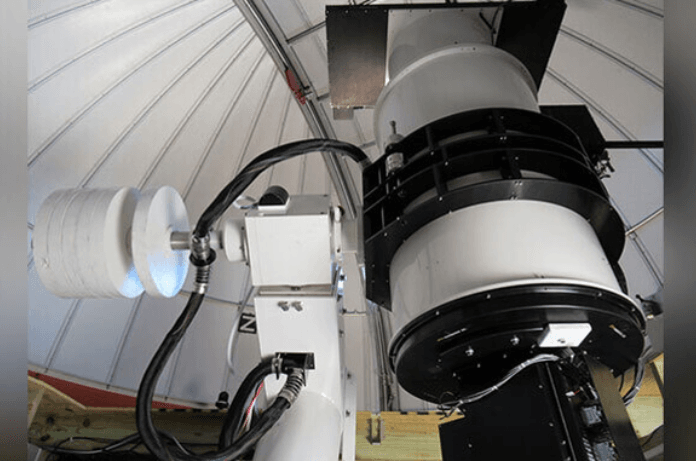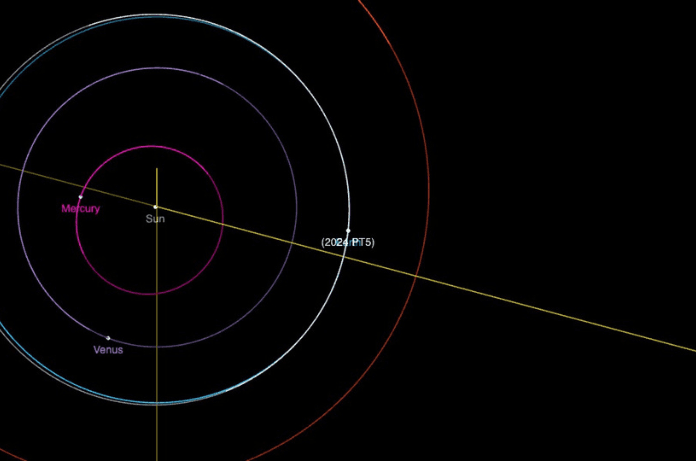Have you ever thought what if Earth has more than one moon? Well, you are in for a surprise! While we all know and love our big, bright Moon, Earth occasionally captures temporary mini-moons like small asteroids that get caught in Earth’s gravity and stick around for a short time before heading back into space. Meet the latest one- 2024 PT5!
The Moon, Earth’s closest celestial body will be joined by a new neighbor, a second moon. Scientists are calling 24 PT5 an asteroid a Mini Moon. This mini moon will also be spinning around the Earth before it breaks free of the Earth’s planet’s gravitational orbit.
What is the Earth’s New Mini Moon?
When asteroids hit Earth, they typically either fly by the planet or hit it and leave a streak in the sky or a hole in the Earth’s crust. However, in a few cases, they are captured by Earth’s gravitational pull becoming a Mini Moon of sorts.
PT5 was first observed on August 5th by the Sutherland, South Africa telescope of the University of Hawai’i’s Asteroid “Terrestrial Impact Alert System” or ATLAS, which was funded by NASA. Earth will have its second moon for 56.6 days to be precise.

The mini-moon has come from the Arjuna space rock belt, which is a group of asteroids 93 million miles away. This rock with a diameter of 10 meters roughly the length of a typical transport bus will be captured by the Earth’s gravitational pull and orbit of our planet till the 25th of November.
Is PT5 Earth’s first mini-Moon?
So, this is not the first mini-moon the Earth has had, non- earth objects or NEOs have entered the Earth’s orbit before as well. Various moon events can be categorized into two types-
– Long captures: Lasting 1 years or more
– Short captures: Lasting days, weeks, or months
The events take place every 10 to 20 years and short captures like the one involving 2024 PT5 that we are hearing about are more frequently happening several times each decade. This is not the first time such an event has occurred, in 2006 an asteroid orbited Earth for nearly a year, and another asteroid orbited for several years finally leaving in the year 2020.
Can we see the Second Moon with a bare eye or a telescope?
While the presence of a new Mini Moon is exciting for astronomers and space enthusiasts most skywatchers will be unable to see 2024 PT5 due to its small size as per a report by space.com. At just 10 meters wide the asteroid is too tiny to be visible to the naked eye or even to most telescopes. While our Moon is 3,474 kilometers in diameter, mini-moons like 2024 PT5 are usually less than 10 meters wide. That’s a huge difference!
Sometimes mini-moons are mistaken for old rocket parts or space junk. It takes careful observation to tell them apart from human-made objects. But By analyzing the light reflected off its surface, scientists can determine the asteroid’s mineral makeup, which could provide insights into the building blocks of the early solar system. This data could also inform future asteroid mining missions, which aim to extract valuable metals from these small bodies.
What Makes 2024 PT5 Special?
Here are some cool things about 2024 PT5:
Size: While it’s smaller than our permanent Moon, 2024 PT5 is thought to be around 3-6 meters in diameter. Imagine a rock the size of a bus or two, big enough to notice, but small enough to escape attention for a while.
Orbit: Unlike our Moon, which has a stable orbit around Earth, 2024 PT5’s path is unstable and random. It’s being pulled by both Earth’s and the Sun’s gravity, and eventually, it will break free and head back into space.
Short Capture: Unfortunately, 2024 PT5 won’t be with us for long. Specialists foresee it will leave Earth’s circle at some point in late 2024 or early 2025 So if you’re hoping to see it, the time is now!
What is the future of Mini Moon PT5?
2024 PT5 is an asteroid, a small space rock discovered in the summer of 2024. Unlike our permanent Moon, 2024 PT5 is just a temporary visitor.
Circulations say that 2024 PT5 space rock will pass by the Earth again in January 2025 and afterward once more in the year 2055 as well.
2024 PT5 won’t be around forever, but it’s still exciting to have it hanging out with us for now. It’s a reminder of just how much movement and activity there is in our solar system!
These mini-moons, though small and temporary, offer a glimpse into the dynamic nature of space. They show us that Earth isn’t as lonely as we might think but there’s always the potential for new discoveries, whether they’re asteroids, comets, or other celestial bodies just passing by.
For researchers, smaller-than-expected moons like 2024 PT5 are priceless. They help us refine our understanding of space debris, asteroid movement, and even the gravitational relationships between Earth and nearby objects.
And for the rest of us? Well, it’s just pretty cool to think that Earth occasionally has more than one moon, even if it’s only for a short time. So, if you ever get the chance to see a mini-moon in the night sky, know that you’re witnessing a rare and exciting event, a visitor from the depths of space, here today, gone tomorrow.
2024 PT5 may not be as impressive as the Moon we see every night, but it’s a fascinating reminder that there’s always something happening in space. Even though it’s only here for a short time, 2024 PT5 gives scientists a chance to study these rare mini-moons up close. So, next time you look up at the night sky, remember that Earth might have a second moon for a little while!

